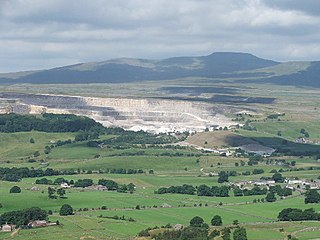
The Buxton lime industry has been important for the development of the town of Buxton in Derbyshire, England, and it has shaped the landscape around the town.

The Buxton lime industry has been important for the development of the town of Buxton in Derbyshire, England, and it has shaped the landscape around the town.
The White Peak area of the Peak District is named after the limestone plateau landscape of the 'Derbyshire Dome'. This limestone outcrop is surrounded by a horseshoe-shaped formation of younger sandstones (gritstones) and shales. Buxton is at the western edge of the limestone region. The layers of carboniferous limestone were deposited in a warm shallow sea in the Brigantian stage of the Carboniferous period (around 330 million years ago). These deposits were compressed into rocks which over time were uplifted and folded into a dome. Erosion of the younger sandstones exposed the limestone strata. The limestone in the Bee Low and Woo Dale limestone formations around Buxton is of unusually high quality, with less than 3% dolomite and less than 1% chert. [1] [2]
Limestone has been quarried as building stone in the Buxton area for centuries.
Lime (also known as quicklime) is produced easily by heating limestone and it has been used for thousands of years. Lime mortar (a mix of lime, sand and water) has been used since ancient times for fixing together the stone blocks of buildings. Lime became used as a soil improver in agriculture since the late Middle Ages. Before electric lights, lime was burnt to light theatrical shows, putting the stage performers 'in the limelight'. Traditional round 'pudding pie' lime kilns were built around Buxton to burn limestone that was layered with wood, coal or coke. The lime powder was drawn from the bottom of the kiln, after it had burnt for 3 to 5 days and then cooled for a further 2 days. The process generated huge quantities of burnt waste material, taking 3 tonnes of limestone and 3 tonnes of coal to make 1 tonne of lime powder. [1]

Grin Low was the main location in Buxton for the early lime industry. It was an extensive area of limestone quarrying and was licensed for lime burning from 1662 by the 1st Duke of Devonshire. Demand for lime grew dramatically during the Industrial Revolution. There are widespread remains of over 100 large lime kilns, built of earth and rock, which date from the 17th–19th centuries. The land is also covered in spoil heaps of waste material. Coal came from local collieries at Axe Edge and Goyts Moss. In 1820 the 6th Duke of Devonshire commissioned the 'Grin Plantation' (now the wooded Buxton Country Park) to shield the scarred lime-burning landscape from visitors to the spa town of Buxton. In the 1850s lime production at Grin Low moved to a new large quarry on the south side of the hill (which was operated until its closure in 1952). In 1890 Grin Low produced 90,000 tonnes of lime. [1] [3]
Grin Low Wood is a designated Site of Special Scientific Interest (SSSI). [4]
Lime burning had also taken place at Dove Holes since 1650. The opening of the Cromford and High Peak Railway in 1831 generated expansion of quarrying around Buxton, with 4 new quarries: Harpur Hill Quarry in 1835, Perseverance in 1847, and Holderness and Bold Venture in 1857 at Dove Holes.

In 1861 Belgian chemist Ernest Solvay developed the Solvay process (also called the ammonia-soda process) for the production of soda ash (sodium carbonate) from salt brine and limestone. Soda ash (or washing soda) was used for producing soaps, for dying textiles and for making glass.
The Brunner Mond company was formed in 1873 by John Brunner and Ludwig Mond. In 1874 they started using the Solvay process to make soda ash at Winnington works in Northwich, from the large local salt deposits and with limestone from Derbyshire. The soda ash was needed for the Lancashire cotton industry and for glass manufacture in St Helens. [5] [6]

The arrival of the main railway lines from Manchester and London to Buxton in the 1860s prompted the opening of many further quarries: Victory in 1863, Ashwood Dale in 1864, Great Rocks in 1869, Peak Dale in 1877, Oldham Lime in 1878, East Buxton in 1880, Hindlow in 1882 and Buxton Central in 1885. [1]
Buxton Lime Firms (BLF) was formed by 13 competing quarry owners in 1891. BLF controlled the price of stone and lime from its 17 initial quarries. BLF owned over 1500 acres of land with about 100 lime kilns and 3 collieries. It produced 360,000 tons of limestone and 280,000 tons of lime per year. Larger, more advanced kilns were now in use and firebricks were introduced into kilns from 1907. By 1915 BLF had developed or acquired an additional 9 quarries including the opening of: Small Dale in 1891, Dowlow in 1898, Buxton South in 1900, Topley Pike in 1907, Brier Low in 1907, Cowdale in 1908. BLF supplied increasing quantities of lime to Brunner Mond until Brunner Mond acquired BLF in 1919, when Bee Low quarry was also opened. [7] [8]

In 1926 Imperial Chemical Industries (ICI) was formed through the merger of Brunner Mond, Nobel Industries, United Alkali Company and British Dyestuffs Corporation. Buxton was the headquarters for I.C.I. Lime Division, with its main offices in the old Royal Hotel building on Spring Gardens. Hillhead quarry was opened in 1927 followed by Hindlow Lane in 1928 (which was expanded with seven new kilns in 1930–31). Development of the current works at Tunstead quarry did not commence until 1929, following the expiry of leases on various other quarries in 1922. [7]
During World War II, open-topped kilns were decommissioned due to strict blackout regulations for air raids and many quarries closed. [8]
In 1992 I.C.I. sold its Lime Division to Anglo American as Buxton Lime Industries, which became part of its UK Tarmac operation. [2]

Modern quarrying is a high-technology industry using advanced machinery, supplying concrete and cement to the construction industry. Several active limestone quarries are still located close to Buxton, [9] including the "Tunstead Superquarry", operated by Tarmac in Great Rocks Dale. [10] It is the largest limestone quarry in the UK producing 5.5 million tonnes per year, a quarter of which is used by the cement works on site. [2] Tarmac also operates the Hindlow Quarry at Sterndale Moor. Breedon's Dowlow Quarry is also at Sterndale Moor. The Great Rocks Line runs between these quarries and Buxton, where it joins the main railway network. The Topley Pike Quarry is now owned and run by Aggregate Industries.

Buxton is a spa town in the Borough of High Peak, Derbyshire, in the East Midlands region of England. It is England's highest market town, sited at some 1,000 feet (300 m) above sea level. It lies close to Cheshire to the west and Staffordshire to the south, on the edge of the Peak District National Park. In 1974, the municipal borough merged with other nearby boroughs, including Glossop, to form the local government district and borough of High Peak.
The Leblanc process was an early industrial process for making soda ash used throughout the 19th century, named after its inventor, Nicolas Leblanc. It involved two stages: making sodium sulfate from sodium chloride, followed by reacting the sodium sulfate with coal and calcium carbonate to make sodium carbonate. The process gradually became obsolete after the development of the Solvay process.
The Solvay process or ammonia–soda process is the major industrial process for the production of sodium carbonate (soda ash, Na2CO3). The ammonia–soda process was developed into its modern form by the Belgian chemist Ernest Solvay during the 1860s. The ingredients for this are readily available and inexpensive: salt brine (from inland sources or from the sea) and limestone (from quarries). The worldwide production of soda ash in 2005 was estimated at 42 million tonnes, which is more than six kilograms (13 lb) per year for each person on Earth. Solvay-based chemical plants now produce roughly three-quarters of this supply, with the remaining being mined from natural deposits. This method superseded the Leblanc process.

The Cromford and High Peak Railway (C&HPR) was a standard-gauge line between the Cromford Canal wharf at High Peak Junction and the Peak Forest Canal at Whaley Bridge. The railway, which was completed in 1831, was built to carry minerals and goods through the hilly rural terrain of the Peak District within Derbyshire, England. The route was marked by a number of roped worked inclines. Due to falling traffic, the entire railway was closed by 1967.

Buxton railway station serves the Peak District town of Buxton in Derbyshire, England. It is managed and served by Northern Trains. The station is 25+3⁄4 miles (41.4 km) south east of Manchester Piccadilly and is the terminus of the Buxton line.

Tunstead is a village in Derbyshire, England, situated above Great Rocks Dale north of Buxton. It should not be confused with Tunstead Milton, which is roughly five miles to the north west. It is in the civil parish of Green Fairfield.
Tata Chemicals Europe is a UK-based chemicals company that is a subsidiary of Tata Chemicals Limited, itself a part of the India-based Tata Group. Its principal products are soda ash, sodium bicarbonate, calcium chloride and associated alkaline chemicals.
The Ashbourne line was a 33+1⁄2 mi (53.9 km) railway from Buxton via Ashbourne to Uttoxeter. It was built by the London and North Western Railway using a section of the Cromford and High Peak Railway (C&HPR) and it joined the North Staffordshire Railway at Ashbourne, proceeding to Uttoxeter with a junction onto the main line at Rocester.

Dowlow Halt was opened in 1920 between Dowlow and Greatlow to the south east of Buxton, Derbyshire on the London and North Western Railway line to Ashbourne and the south.

King Sterndale is a village and civil parish in Derbyshire, England. It is located in the Peak District, 4 miles east of Buxton. It has a population of about 30, increasing to 133 at the 2011 Census. The two hamlets of Cowdale and Staden also lie within the parish.

Great Rocks Dale is a dry valley in the Derbyshire Peak District, known for its extensive quarrying.

Harpur Hill Quarry is a disused limestone quarry on Harpur Hill, Derbyshire, England. Limestone was extracted there from 1835 to 1952 for lime burning at lime kilns to produce quicklime. The quarry was used by the Royal Air Force as a chemical weapons storage depot during the Second World War, the largest such depot in the United Kingdom. Afterwards a number of captured German chemical munitions were disposed of at the site by burning, which was only partially successful. The RAF depot closed in 1960 and the site is now vacant.

Chee Dale is a steep-sided gorge on the River Wye near Buxton, Derbyshire, in the Peak District of England.

Deep Dale is a short steep-sided gorge near Buxton, Derbyshire, in the Peak District of England. It is distinct from another Deep Dale, near Sheldon, 4 miles (6.4 km) to the east.

The Derbyshire Dome is a geological formation across mid-Derbyshire in England.

The Wye Valley is the limestone valley of the River Wye in the White Peak of Derbyshire, England. The source of the River Wye is west of Buxton on Axe Edge Moor. One main channel runs underground through Poole's Cavern. The river flows though Buxton Pavilion Gardens and then along a culvert under the town centre. After leaving the flat area of central Buxton, the Wye Valley becomes distinct as a gorge running east for 10 miles (16 km) before the valley broadens at Ashford-in-the Water.

Grin Low is a hill overlooking Buxton in Derbyshire, in the Peak District. The summit is 434 metres (1,424 ft) above sea level.
Dowlow Works is a quarry in High Peak, Derbyshire near the village of Earl Sterndale. The quarry has been in operation since 1899, and has extracting permissions until 2046. It produces agricultural lime, crushed rock, white limestone and associated asphalt products.

Hope Cement Works, is a cement plant located near to the village of Hope in Derbyshire, England. The plant is mostly self-contained with its own shale and limestone quarries adjacent, with only fuel and small amounts of additives needing to be brought in. The site is located inside the Peak District National Park, and so is subject to tighter planning restrictions than other cement plants in the United Kingdom. It is now the largest cement plant in the United Kingdom, and is also one of the largest emitters of CO2 within the national park.

Horton Quarry is a limestone quarry near to Horton-in-Ribblesdale, North Yorkshire, England. The quarry, which is some 6 miles (9.7 km) north of Settle, has been operating since at least 1889, and produces limestone for a variety of purposes. Stone used to be exported from the quarry by rail, but now leaves by lorry, although there are plans to re-instate the railway sidings. The quarry used to produce its own lime by roasting the limestone in big kilns on the site, but the last of these were removed in the 1980s. Since 2000, the quarry has been owned and operated by Heidelberg Materials UK.